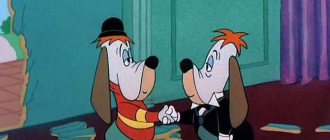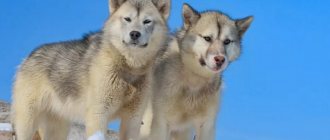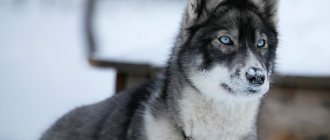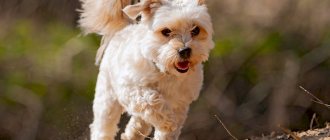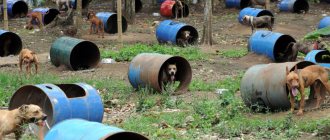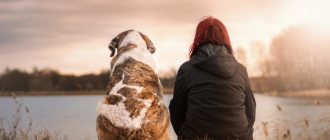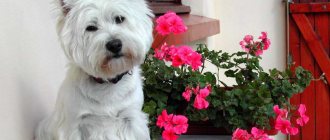Chukotka sledding
- an aboriginal breed of dog, bred in Russia by the peoples of the Far Northeast Asia. Not recognized by the Fédération Cynologique Internationale.
It is unpretentious in maintenance, easy to train, retains acquired skills for a long time and is adapted to the harsh Arctic climate. Very strong soft toes make the Chukchi sled dog indispensable when driving on sea ice and mountain tundra; the structure of the paws ensures reliable grip on difficult types of soil[1][2]. It has a number of advantages in comparison with factory sled breeds, including an energetically favorable protein-fat metabolism type in polar conditions, as well as maximum endurance and performance[1].
The main livestock is concentrated in the populated areas of Chukotka, where dogs are traditionally used in winter as transport and for hunting sea animals, and in summer they are harnessed to wheeled carts and transport cargo. When moving, the back and lower back are springy, the limbs are carried far forward, the typical gait is a trot. Several fairly isolated populations provide the gene pool of the breed. The Chukotka sled dog is very promising for competitions in sports racing, especially at long and ultra-long distances[1].
A dog's reaction to a person can be either friendly or passive-defensive. The first dog of this breed received the title “RKF Champion” in 1999[1].
Appearance
The dog is of medium height, with strong bones and well-developed muscles, somewhat elongated, with an index of 104-109, format, sexual dimorphism is weakly expressed. Important proportions include the length of the body, which exceeds the height at the withers by 4-9%; chest depth, slightly less than half the height at the withers; approximately equal in length to the muzzle and skull. The height at the withers of males is 56-65 cm, females 53-62 cm[1].
The head is massive, wide in the frontal part, the cheekbones are well defined. When viewed from above, the shape is close to an equilateral triangle. The skull in the frontal part is wide, the cheekbones, brow ridges and occipital protuberance are well defined. The length of the skull is approximately equal to the width, the transition from the forehead to the muzzle is clear, but not sharp. The profile of the muzzle is wedge-shaped, blunt, its line is parallel to the line of the forehead. The lips fit tightly, the nose is large, black; in light-colored dogs it can be lightened, in brown dogs it can be brown. The teeth are large, white, scissor bite, sometimes straight. The eyes are oval, obliquely set, from dark brown to light brown. The ears are erect, set wide apart, relatively small, very mobile, often hanging down, and their shape approximates an equilateral triangle. Slightly rounded ends are possible. The ears are slightly directed forward, voluminous, covered with hair[1].
The neck is massive, of medium length, set at an angle of 40-45° to the line of the back. The chest is wide, long, oval in cross-section, its lower line is not lower than the elbow. The withers are of medium length, protruding slightly above the line of a straight, broad, strong, muscular back. The loin is wide, strong, muscular, slightly convex; the croup is long, wide, muscular, slightly sloping; the stomach is moderately tucked[1].
The angles of the joints of the forelimbs are well defined, the shoulder blades are long, obliquely set, the angles of the humeroscapular joints are about 100°, the humerus are of medium length, the forearms are vertical, the metacarpus are well developed, powerful, set slightly obliquely, of medium length. The hind legs are set wider than the front legs, slightly extended, and when viewed from behind they are straight and parallel. The thighs are well muscled, of medium length, equal to the length of the legs, the angles of the articulations are well defined. The hocks are set vertically. The paws are large, rounded, spread out. The fingers are strong, fairly mobile, strong, with very dense thick skin on the crumbs[1].
The tail is evenly feathered, set slightly below the line of the back, reaching the hock joint or shorter. In a calm state, it is lowered like a log or slightly curved upward; in an excited state, it is raised above the line of the back with a sickle or a semi-ring [1].
The coat is double, with a thick, waterproof undercoat, allowing it to spend the night under the snow[2], on the body up to 6 cm long, coarse straight guard hairs are well developed. The muzzle, forehead, ears and front surface of the limbs are covered with shorter dense hair, the neck, withers and back of the thighs are covered with longer hair, about 8-10 cm, while an abundant mane and pants are not formed. The longest hair is on the tail - from 10 to 12 cm. Colors - zone-gray, zone-red, light fawn, red, white, brown, black, spotted, piebald, tan, domino-type lightening is often found[1 ].
Interesting Facts
Sled dogs are very curious animals. Everyone knows that they can be used to move and transport goods, but there are several interesting facts that most people do not know about.
- The history of the use of dog sleds goes back at least 8 thousand years. Confirmation of this was found on the territory of the New Siberian Islands, which belong to Russia.
- Without sled dogs, the white spots on the world map would disappear much more slowly - for example, the first conquerors of the poles got to the coveted point on sleds.
- Dogs of the above-described breeds are capable of covering 80 kilometers in a harness in a day. At the same time, the musher, that is, the rider, must ensure that the animals do not become overtired, and therefore the speed limit for them is no more than 12 km/h.
- In a sled, the load on all participants must be equal, and if one of the dogs is “sloppy,” he will be punished by the leader at the nearest parking lot, when the musher releases the animals.
- Unlike horses and most other livestock, there are no physical cues used in dog sleds - there are no whips or reins, and the animals are controlled solely by verbal voice commands. At the same time, the rider must win the respect of his “engine”, otherwise there can be no question of proper obedience.
- Smart sled dogs have a soul of their own - they want not only a tasty treat as a reward, but also obvious praise. Experienced mushers at stops always approach each pet and express their gratitude - they will pet this one, pat this one a little on the withers, scratch the third one. At the same time, the dogs are jealous of the owner and if they notice that he has singled out one, they will give the pet a thrashing.
Literature
- Kryuchkin V.
Return of the Chukotka sled // Around the world: magazine. - 1989. - No. 2. - ISSN 0321-0669. - Potselueva E., Chebykina L.
Aboriginal breeds - myth or reality? // Friend: magazine. - 2002. - No. 11 (105). - P. 36-41. — ISSN 1609-0527. - Potselueva E.
My Chukchi sled dogs // My friend the dog: magazine. - 2014. - No. 3. - P. 62-64.
The Chukotka sled dog is an indigenous breed of dog that developed in the harsh climate of the Arctic. These amazing animals are unpretentious in maintenance, have excellent driving qualities, are well trained and retain their acquired skills for a long time, and are phenomenally resilient. Chukotka sled dogs have been indispensable human assistants for centuries and today are used by the indigenous population as a means of transport.
Notes
- ↑ 1 2 3 4 5 6 7 8 9 10
Chukotka sledding.
RKF standard (undefined)
(doc). Russian Cynological Federation. Access date: November 30, 2016. - ↑ 1 2
Photos and comments to the standard of the Chukotka riding style
(unspecified)
(doc). Russian Cynological Federation. Access date: November 30, 2016.
Origin story
The Chukotka sled dog is aboriginal in a positive sense, it is close to its primitive ancestors, it was formed under the influence of the environment and spontaneous selection for qualities that are necessary for versatile use. Folk selection did not pursue the goal of changing the dog’s appearance or improving it in any way, therefore there are no overdeveloped articles in the Chukotka Sled Dog. It combines natural harmony and functionality.
For thousands of years, dogs have been constant companions of the Eskimos and Chukchi.
Until the 1950s, there were more than 10 groups of aboriginal sled dogs in Russia. In the 50s they were “abolished” and combined into the “North-Eastern Sled Dog” breed. This mixed breed was excluded from the list of domestic breeds in the late 60s. Sled dog breeding was preserved only where technology could not replace dogs, and breed groups were again identified according to their habitat. Some of them are already officially recognized by the RKF, and the Yakut Laika is even tentatively recognized by the FCI.
Thanks to the joint work of mushers, dog handlers and scientists, the Chukotka Sled Dog was officially recognized by the Russian Canine Federation. The standard was finally approved in 2013.
Using the Chukotka sled
The main livestock is concentrated in villages on the Chukotka Peninsula, where dogs are still used for their intended purpose. In winter for hunting and as a reliable vehicle for towing, transporting people and cargo. In recent decades, they have often participated in sled dog sports competitions and have shown excellent performance over long and ultra-long distances. Less commonly, they protect and herd herds of deer, like Nenets huskies.
Old people say that they even hunted polar bears with the help of a dog sled. When the dogs smelled the clubfoot, the hunter jumped off and sent the team forward. The dogs picked up speed and turned sharply in front of the hunted object. The sledges crashed into the bear and knocked him down, and the hunter ran up and used a spear.
Today, the coastal Chukchi continue to use Chukchi sleds for seal hunting. In winter, this type of seal contains several holes through which it breathes. A hunter sits down next to one. The dog runs around the others and does not allow the seal to surface. When she nevertheless surfaces near the hunter, he harpoons her and catches her. The skills of hunting fur-bearing and ungulate animals with sled dogs have mostly been lost.
Application
For centuries, the Yakut Laika has been an assistant to the family and its full member.
And now the breed has not lost its versatility:
- These are sled dogs. They are smart, obedient, hardy. They are not afraid of frost.
- YAL - hunters. They can be trained for any animal: fur-bearing, ungulate. They are not afraid of bears and moose.
Yakut huskies are easy to train and run in harnesses. Freestyle, frisbee, general course - they master everything quickly. After 9 months, you need to get used to physical activity. The main thing in education is firmness. Cruelty is prohibited. From such an attitude, the dog loses its qualities, becomes angry and disobedient.
Appearance
The Chukotka sled dog is a dog of medium height, slightly elongated, strong build, with developed muscles and strong bones. Thick leather does not form folds. Sexual dimorphism is not clearly expressed. Height at withers 52-65 cm.
The head is massive, wide in the frontal part. The muzzle is wedge-shaped, blunt. The lines of the forehead and muzzle are parallel. The lobe is large, pigmentation depends on the color. Scissor bite or straight bite. The eyes are oval-shaped, brown in color. The ears are relatively small, erect, with slightly rounded tips, directed slightly forward, voluminous, mobile, often hung. The neck is massive, of medium length, set at an angle of 40-45 degrees to the line of the back.
Externally, Chukchi sled dogs are the most ordinary, similar to mongrels. But these are one of the hardiest dogs with webbed paws to prevent them from sinking in the snow.
The body is strongly built, the length exceeds the height by 4-9%. The chest is oval in cross-section, long and wide. The back is straight, muscular, wide. The loin is slightly convex. The croup is sloping. The stomach is moderately tucked. Forelegs with pronounced angles. The hindquarters, when viewed from behind, are straight and parallel, set wider than the front ones, slightly drawn back, the angles are well defined. The paws are rounded and spread out. The fingers are strong with thick and dense skin on the crumbs. The tail is evenly feathered, set just below the line of the back, reaching to the hock joint or shorter.
The skin is elastic and dense. The coat is double coated with a coarse straight spine and a thick undercoat that has waterproof properties. On the body, the outer hair is up to 6 cm long. On the muzzle, forehead, ears, and front surface of the limbs it is shorter and denser. Long on the neck, withers and back of the thighs, but does not form an abundant mane or pants. Hair length 10 cm. On the tail - 10-12 cm. Does not form a dewlap. The summer coat is much poorer.
Colors: zone-gray, zone-red, fawn, white, red, black, brown, piebald, tan, spotted.
The breed standard contributes to the conservation and restoration of populations that are on the verge of extinction. Hence the rather wide scope of parameters.
Mediterranean pointy-eared
The history of these dogs goes back almost 5 thousand years. People used them for work, less often for hunting. Now representatives of the group are rare, which is why the price for them reaches hundreds of thousands. Breeders are actively working on them to improve their appearance, but this has led to the fact that there are no longer any Mediterranean pointy-eared animals that have not changed as a result of human influence.
Cirneco del Etna
Another name is Sicilian Greyhound. Cirnecos are native to Sicily, where they were used to hunt hares.
The dog has a refined, light build. Height and weight are average. Cirnecos appear fragile, but they are strong and tough. The coat is short and harsh, fawn in color with dark or light shades.
Cirnecos quickly become attached to their owners and have a gentle disposition. With age, they lose their playfulness and become calmer. They can even sleep for days. They get along well with children and other animals.
Ibizan dog
Previously, Ibissa, also known as Podenco Ibicenco, was used for hunting small game. Now they are racing participants and companions.
Ibissus is tall and slender, with long legs. The coat can be smooth and hard. Color red, white or mixed.
Podenco Ibicenco has a lively mind and a large supply of energy. Girls have a more obedient disposition and love to work. Boys strive to show dominance and do not get along well with other animals.
Itvina
Itwina is native to North and East Africa. Local tribes used them to hunt big game. In the 19th century, Europeans noticed the breed and began to actively crossbreed it with others to improve its qualities.
She is light and agile, strong and muscular. The coat is short, hard, and light in color. The character is confident and strong, independent. They can be stubborn and require a firm hand and experience in education.
Pharaoh Hound
National breed of the island of Malta. There it is known as "rabbit". This is due to the purpose - rabbit hunting. But it has nothing in common with Ancient Egypt.
The Pharaoh Hound is light and elegant. The physique is ideal for hunting. The coat is bright red or brown, short.
By nature, pharaohs are playful and active. They are smart and easy to train. They are sociable, but distrustful of strangers. They can be stubborn, but they are affectionate with their family.
Portuguese Podenco
National breed of Portugal. Comes in three sizes. Large dogs were previously considered animals of the noble class, while medium and small dogs were considered the animals of commoners. The former used them for hunting wild boars, the latter for rabbits.
Regardless of their size, mayflies are harmoniously built and have well-developed muscles. The coat is short and coarse - the coat depends on the climatic conditions of the region of residence. Color – yellow and fawn.
Podencos are smart, active, with a stable psyche. They are obedient and get along well with animals and children. They treat strangers with distrust.
Andalusian Podenco
The hunting qualities of Andalusian Podencos are so developed that they are still used to hunt small game and rodents. Like the Portuguese, the Andalusian has 3 types of sizes: large, medium and small. The coat can also be different: hard, long, silky and short. The color is brown with white spots or white with brown spots.
Podenko is distinguished by special loyalty to its owner. Always happy to spend time with people. He only accepts animals that he grew up with. The character is calm and obedient. Although without attention it can be excessively intrusive.
The list of native dog breeds is long, but few know who is included in it. They developed in one region, in close interaction only with representatives of their breed. Many of them are not accustomed to human company, but with proper upbringing they will grow into loyal and obedient comrades.
Character and behavior
The Chukotka sled dog is a hardy, strong, patient and obedient dog, a bright representative of ancient primitive breeds. Combines many talents. It can be a sled dog, a hunting dog, a faithful companion and protector of the owner. The attitude towards strangers is friendly or passive-defensive. Chukotka sled dogs perform a good guard function; many are able to protect their owner from predators.
The Chukotka sled dog is not popular among city residents. In terms of appearance and beauty, it is inferior to huskies or other huskies. In addition, this is an aboriginal dog, a pack dog, while huskies and huskies are individualists.
Chukchi sled dogs have a highly developed pack instinct. A strict hierarchy reigns in their “family” and only the sensitive leadership of the leader allows them to avoid minor brawls. This role can be performed by either a male or a female. Sled dogs are very kind and trusting. They sometimes bark at strangers, but more often they greet by wagging their tail and howling. Do not apply to dogs of the same owner. With sled dogs, the owner is the one who feeds. Therefore, animals are often rented out.
The leader for the team is chosen in early childhood. Puppies are placed in a basin on a skin, they get out, but are not held on the edge and fall down. The one who can hold on and walk along the edge becomes the leader. According to experts, such a dog will be able to lead a sled in any weather, at any time of day, on any terrain. Or they simply choose the strongest and, in the person’s opinion, the smartest. Leader training begins at six months of age and continues for 2 years. No “voice” or “give me your paw.” There are only four commands: “Forward!” (“Hike!”), “Stop!” (“Hoa!”), “Right!” (“Gee!”) and “Left!” ("Ha!"). The musher commands only the leader, this is enough for the entire team to obey.
It was the Chukchi huskies that were chosen for the most difficult joint expedition of Fyodor Konyukhov and Viktor Simonov. They had to go from Karelia to southern Greenland via the North Pole. Travelers with dogs started in Petrozavodsk on April 3, 2013. Due to early warming and the movement of polar ice, the route was interrupted and the expedition was postponed. Subsequently, it never took place.
Reviews
Nadezhda Anatolyevna, Moscow region: “I have extensive experience working with dogs. But I always dreamed of a Chukchi sled dog and ended up getting a wonderful dog. At first, he and I could not find a common language, since the dog turned out to be quite peculiar, with its own wonderful idea of the world. But patience and work have overcome everything, now the sled dog works on an equal basis with the others, knows the commands, and is socialized. Well, except that it’s problematic for us to perform “nearby”.
Tatyana Alekseevna and Dima Tarasov: “Wonderful, smart, unusual dogs! We talked to them when we went sledding in the region. How obedient they are, how strong! We are impressed!”
Content Features
The Chukotka sled dog is ideally suited for life in the Arctic. Keeping such a dog in a city, and even in a warm climate, is extremely undesirable. This is an exclusively working breed, it needs appropriate living conditions and physical activity.
Like other sled dogs, Chukchi dogs must run, otherwise they will go crazy from boredom. They can take out a nervous breakdown on objects or the body, for example, they will gnaw a paw to the bone, this has happened.
Owners who tried to keep Chukchi sled dogs in the city complained about their excessive mobility and independence. When walking, they should not be let off the leash, otherwise they will run off into the distance with their tails in the air. They take root well in private homes in the northern regions.
The record for speed and endurance belongs to Chukotka riders. A team can travel from 100 to 200 km per day at an average speed of 20 km/h.
Nutrition
The digestive system is adapted to the traditional food of northern dogs: frozen fish, meat, fat, offal. They are indiscriminate and undemanding when it comes to food.
There is an opinion that if the owner has nothing to feed the sled, she will go off to get food herself. But it is worth noting that most modern Chukchi dogs do not have the appropriate hunting instinct and are worse adapted for independent survival than their ancestors. What they have retained is the energetically beneficial protein-fat type of metabolism, which allows them to easily endure several days without food and spend energy sparingly.
Samoyed husky
The Samoyed Laika is characterized by the greatest attractiveness and charm among all sledding breeds. Possessing a charming “Eskimo smile”, the friendly Samoyed (after the name of the first breeders - the Samoyed tribe) feels great in the family. This breed is over 3000 years old. Many question the fact that representatives of this breed were previously used as real sled dogs. Although we can safely say that representatives of this breed were used as sled dogs (they can pull a load 2 times heavier than their personal weight), but their true purpose is to protect and help in the hunt.
Samoyed huskies are medium-sized dogs, up to 60 cm at the withers, but their fluffy coat, which is thick, abundant, dense and shiny, makes them appear larger. Their color can be white, cream, or fawn, and the ends of the hairs are silvery. They are loyal, smart, and easily understand their owners. Samoyeds are also distinguished by their extraordinary health and endurance. These are real hardy workaholics. They are suitable, like almost all sled dogs, to be kept in their own home, in the open air, and an apartment for keeping such pets is not considered.
Important! Samoyed huskies are the only sled dogs that are purebred Spitz dogs, without any mixing with wolves.
Samoyeds, unlike other sled dog breeds, have an extraordinary trait - obedience, and therefore are well trained. But in this matter, the owner needs to be patient, show care, and not show aggression or force. They are also characterized by a friendly attitude towards people, unpretentiousness, spontaneity, and adaptability to any conditions of detention. These animals have strong immunity and are not susceptible to almost any disease. They do not tolerate loneliness well, they need communication with the owner and other family members.
Samoyeds are characterized by openness, friendliness, independence, loyalty, and are intelligent dogs with a cheerful disposition. They do not show aggression or fearfulness, they love games, competitions, and walks with their owner. Samoyeds themselves will never become the instigators of a fight, but they will not allow themselves to be offended either. Like real guards, they have a heightened sense of danger. These dogs do not require special care; they need to be bathed, dried, and combed.
Important! In the USA, doctors prescribe communication with the Samoyed Laika for those suffering from depression and feelings of loneliness, considering these animals as dogs for a positive mood.
Breeding Chukchi sled dogs
The main population of representatives of this unique breed is concentrated in Yakutia and Chukotka. There are several dogs in one of the Moscow nurseries. It will not be easy to buy a good working sled dog, and even a purebred one, but you can see them and ride in a harness. For example, in the Moscow club or in Karelia, in the eco-complex of Viktor Simonov Husky Moa. 90 sleds live here, most of whom are Chukotka.
Price
From 20 to 60 thousand rubles. They may ask for more for an adult, trained leader.
Norwegian sporting crossbreeds
The very name of the breed speaks about the purpose of these dogs - they are real athletes (ski-joring, bike-joring). Norwegian sports mestizos were bred in the 80s of the last century in Norway by cynologist Niels Andreas Hansen by crossing several breeds: shorthaired pointer, greyhound and pointer. Large shorthaired pointers differed in size, and greyhounds differed in their running speed.
The mixture of these breeds gave excellent results, but it lacked stamina. Therefore, these dogs were once again mixed with shorthaired pointers, resulting in mixed breeds. They ran well, were characterized by extraordinary strength, but were distinguished by aggressiveness towards other dogs, which became a cause of concern for their owners. Therefore, for the next mating, attention was turned to pointers from the large Italian kennel “Vento”. These dogs just lacked power, and they themselves were absolutely non-aggressive.
The result was dogs with sufficient power to pull a skier or other load, intelligence, the ability to develop high speed, and, moreover, without signs of causeless aggression. These dogs were called Norwegian sporting mixes.
A device such as a harness was previously used only in harnesses, but now the accessory is used to control the behavior of a pet during a walk and allows you to keep the dog in a comfortable position.
Description
The breed originated without human participation under the influence of the harsh climate of the far north, so it is rightly called aboriginal. One of the unique features of the breed is the internal regulation of all systems, thanks to which the animal cannot be driven to death, like a horse or husky. No matter how the rider drives, the sled will not go faster than the dogs’ bodies can physically withstand. This is why northern aborigines are highly valued.
Interesting fact
According to archaeologists, dog sledding originated earlier than reindeer riding.
Interesting fact
A hunters' camp was found with traces of sledges and harnesses, as well as dog bones that were more than 7,000 years old.
Interesting fact
Eyewitnesses talk about hunting polar bears. Sensing the presence of Toptygin, the team pulled out in his direction, and the rider barely had time to jump away. Approaching the bear, the sled turned sharply, crashed into the predator, and then the owner approached with a weapon and neutralized the predator.
Interesting fact
Today, the Chukchi go with their native dogs to hunt the seal, which makes holes in the ice for breathing. The man sits near one of them, and the dog watches other holes in the ice. Not allowing the seal to stick its nose out, the aboriginal assistant forces the waterfowl to emerge for a breath of oxygen from the hole of the hunter, who is already ready to catch the seal. The hunting principle is similar to that of a wolf.
Interesting fact
Over the past 25 years, mossy natives have been taking part in sled cart races and successfully performing on super-long tracks. They hold the lead: they are able to run more than 100 kilometers a day at a speed of 20 km/h.
Interesting fact
In Russia, Chukchi sled dogs were officially recognized in the 90s of the last century. In 2013, standards for appearance and defining data were approved. Dog handlers examined 15,000 individuals, of which only 4,000 were recognized as purebred.
Breed Features
The Yakut has a thick layer of upper epithelium compared to the Husky. The coat is smooth, close-lying, and relatively long. Therefore, its owner does not freeze even in severe snowstorms.
It is not surprising that local residents kept dogs in the settlements and used them to transport goods. Easy to train, able to withstand record frosts and unpretentious to food, she has become a reliable assistant for her owners, especially in winter. And strong finger pads make it indispensable when moving on slippery ice or snowy rocky hills.
This hardy and strong, friendly and calm animal is a real treasure that has many talents. Today the Aboriginal hunter is used:
- In sports;
- for harness;
- on the hunt;
- as a companion dog.
Distinctive features
This is a muscular dog of medium size and multi-colored from white to black with gray, brown, red.
Head
Massive with a large forehead and cheekbones. From above it resembles an equilateral triangle. The neck is not long, muscular, located at 45 degrees relative to the back.
Jaws
Strong with a scissor bite. Large teeth, lips tightly fitting.
Ears
Protruding, widely set, triangular, rather small.
Eyes
Oval, brown in different shades.
Torso
The body line is smooth and straight. The chest is oval and deep to the elbows
with convex ribs. The back is straight, wide and muscular. Posture is proud. The gait is swift. The tail is drooping, strong and thick, lower than the back.
Paws
Large, rounded with dense pads. Fingers with thick skin.
Wool
Quite short, hard and dense, with a thick undercoat.
It has waterproof and self-cleaning properties. Sheds little. The length of the hair on the body is up to 6 mm, on the tail 10-12 cm, it does not form a dewlap.
Character
The dog has an independent character, but is absolutely non-aggressive. It does not guard either territory or food, and even with cats “on friendly terms”, it treats strangers kindly.
The relationship with the owners of the four-legged dog is very easy; he immediately accepts his owner and obeys all his commands. However, the pet will not listen to an insecure mentor: it needs a firm leader. Already at the age of six months, he can walk well next to a human leader without a leash and knows basic commands.
Alaskan Malamute
This amazing, beautiful and noble breed of dog from the Arctic is one of the oldest sled breeds used in sledding, sometimes even called the “northern snow train”. The Alaskan Malamute has excellent adaptability to any, even extremely harsh conditions. He is capable of transporting a sled with a person or load over a distance of several kilometers.
The breed got its name from a tribe living in western Alaska. The Alaskan Malamute almost always becomes a real member of the family, everyone's favorite at home. These dogs are characterized by friendliness, sociability, love to play with children, and need attention from their owners.
Did you know? They began breeding purebred representatives of Alaskan Malamutes in 1926, when they managed to obtain positive results in this matter and significantly increase their population. It was only in 1935 that this breed was officially recognized throughout the world. The Alaskan Malamute ranks 18th in the world among 30 popular breeds. In 2010, it was recognized as an honorary symbol of the United States of America.
They have unusual mental abilities, but are also quite stubborn animals, which causes them to often want to dominate other pets and even their owners themselves. At the same time, Alaskan Malamutes are real hard workers who vitally need work and significant physical activity. Without these factors, they can become lazy, and their natural intelligence can degrade.
Alaskan Malamutes are good-natured, generous, loyal, loving and optimistic. They can become true friends for their owners, but you should not expect them to be submissive and obedient.
The Alaskan Klee Kai is a northern Spitz-type dog, similar in appearance to a husky, that can be kept in an apartment and does not require long walks.
These are the largest individuals among sled dogs due to their powerful skeleton and muscles. During the warm season, Alaskan Malamutes feel quite uncomfortable due to their thick coat and undercoat. It is at this time that they require greater care in care.
They are a pack breed and do not tolerate being kept in a closed enclosure or left alone for long periods of time. In this case, they can become withdrawn, stop trusting the owner, loving him and respecting him. Malamute does not like constant routine, the same orders, he can perceive all this as disrespect for him. Because of his goodwill, he cannot be considered a reliable security guard in the full sense of the word, because he will welcome guests and will not rush at a stranger unless there are good reasons for doing so.
The Alaskan Malamute is strongly built, the head is powerful, and the chest is deep. The coat of this dog is something special: its base is hard, with a thick and soft undercoat underneath. The Malamute's coat is almost always oily, this allows it to better retain heat and not get wet. The color of the animal is in gray, white, black and even slightly bluish tones, its eyes are also blue. An adult representative of the breed weighs more than 40 kg, and at the withers his height can be more than 60 cm. The life expectancy of the Alaskan Malamute is up to 15 years. A dog of this breed most often gives birth to 5-6 puppies at a time. The Alaskan Malamute requires high-quality and careful care. He just loves to swim. Its coat needs regular brushing, especially during shedding, and its claws need to be systematically trimmed. Since it is almost impossible to wean a Malamute from the habit of digging the ground, and if he lives in an apartment - the floor, then a private house or cottage is optimally suited for his maintenance.
Did you know? The Alaskan Malamute symbolizes the “gold rush” and is a talisman for the discoverers of Alaska.
Offspring
There are very few nurseries dealing with this species. They are bred in Chukotka, but it is difficult to buy a puppy with a good pedigree, since the necessary documents are rarely prepared. It is also problematic to find a baby with a traceable pedigree.
Puppy cost
15-25 thousand rubles.
26-50 thousand rubles.
51-70 thousand rubles.
Mating and pregnancy
Adulthood occurs at the age of 18-24 months. By this time, a balance is created between physiological maturation and psychological development. You can plan your pregnancy at this time.
Puppies are born after approximately 9 weeks.
There can be up to 10 babies in a litter, and raising them is not an easy task.
Therefore, if you are not breeding, be sure to sterilize your ward.
Nurseries
Parents pass on their qualities to their offspring, so it is better to take Laika puppies with documents and from specialized nurseries.
The following nurseries of Yakut Laikas are known:
- Sakha Dyola in Perm (com/public90435531)
- Diamonds of Anabar, Sochi (arcticdog.ru)
- Free flock Moscow (svobodnaya-staya.com)
The price of Yakut Laika puppies depends on many factors:
- prospects at the exhibition;
- merits of parents;
- number of puppies in the litter and kennel.
A Yakut Laika puppy can cost from 25 to 60 thousand rubles. On the nursery’s website, you can reserve the puppy you like using a photo and arrange an upcoming visit with the owner.
I like3I don't like
Maintenance and care
The fidgety aborigine is distinguished by its unpretentiousness: genes formed in northern conditions have an effect. You can keep it in an apartment, but the ideal place would still be a country house, around which you can run around to your heart's content. Long daily walks are required for apartment dwellers, otherwise the lively animal will direct its energy to pampering, which will anger the owner.
In general, keeping furry northerners is not difficult. The coat should be brushed at least 1-2 times a week, and when shedding, every day. You don't need to bathe often, 1-2 times a year is enough.
Veterinarians recommend not loading the four-legged dog until it is 1 year old, or putting it in a sled, since the dog’s body is just developing. You can do some training: jogging, outdoor games, and develop obedience.
Ideally, before your first trip, Aboriginal transport should be not only fast, but also manageable. When the ward gets stronger and matures, you need to take into account that a sled team requires 6-12 individuals, but even one eared dog can pull skis with a person.
Nutrition
Veterinarians consider it necessary to give fresh food to the living northerners. Their food tract is adapted to the traditional polar dog diet:
It is noteworthy that they retained the ability to withstand hunger for several days.
In addition, the menu should contain:
cereal porridges (oatmeal, rice, buckwheat) for proper functioning of the gastrointestinal tract
kefir, cottage cheese (help strengthen bone tissue)
boiled vegetables and greens (carrots, beets, zucchini)
It is better to chop vegetables and mix them with meat; once a week it is useful to add a clove of garlic.
It is strictly forbidden to give your pet potatoes and any exotic fruits, including citrus fruits.
Pets over 1 year old are fed twice a day, they are given 500-600 grams of food. Month-old babies eat little, but 6 times daily. The owner’s task is to ensure a gradual transition to the diet of an adult animal.
Health and illness
Sled dogs are distinguished by good health, strong immunity and good heredity. The pet should be vaccinated and dewormed on time. The most common ailments:
- hip dysplasia;
- ailments of the knee joints;
- intestinal dysfunction;
- allergy;
- eye diseases;
- hearing impairment.
Health
The Yakut Laika is a healthy and hardy breed. However, like all other dogs, she can have health problems. The animal needs to be examined regularly: look at the gums, check the elasticity of the skin, check for signs of diarrhea, examine the limbs and spine, especially if the dog is used as a sled dog.
Diseases
To keep the animal in shape, you need to monitor the condition of the hip and elbow joints; Yakuts may also have bloating and eye problems.
Vaccinations
Yakuts are no exception and they also need to get all vaccinations.
Mandatory vaccinations against rabies and canine distemper. Also, after consultation with a veterinarian, vaccinations against the following diseases are given:
- Parvovirus enteritis;
- Parainfluenza;
- Leptospirosis;
- Coronavirus.
Piroplasmosis and Lyme disease in dogs are infectious diseases transmitted by infected Ixodid ticks. Therefore, in the autumn-spring period, animals must be vaccinated against them. Now there are complex vaccines against several diseases at once. For example, the vaccine from the Nobivak company.
All vaccinations are given according to the schedule:
- For the first time, Yakut Laika puppies are vaccinated at 1.5-2 months.
- Repeated vaccination after 2 weeks.
- The third after changing teeth (at about 6-7 months).
- The fourth one in a year. Approximately when the dog is 1.5 years old.
- Then every year for the rest of your life.
Before each vaccination, the puppy is dewormed 10-14 days before. Without this procedure, the vaccination will be ineffective.
Sports [edit | edit code]
Currently, sledding sports are divided into two subspecies: snow disciplines and snowless disciplines (dryland). Dryland disciplines (from the English dryland - “dry land”) are carried out on any hard surface without snow. The most famous of them are: canicross (a dog tows a running athlete), bike joring (an animal tows a bicycle), karting (a dog tows a special kart driven by a person) and scootering (the athlete is on a special dog sled scooter).
Dogs of northern breeds are associated with endless polar deserts and eternal snow at the ends of the earth. Thanks to these four-legged friends, people conquered the Arctic, the Far East and Alaska, the poles of the planet. Faithful and devoted pets have been companions to people for hundreds of years, helping them survive in difficult climatic conditions. What is special about these amazing animals? How do they interact with people?
Chinook
The breed was developed at the beginning of the twentieth century. American dog handler, who named her after one of the first representatives. In the selection process, the goal was to select working qualities: speed of movement, adaptation to low temperatures, endurance, athletic build, high intelligence, devotion. They have an unremarkable appearance, but to obtain certain properties of the breed, which is not yet officially recognized, breeders had to make great efforts. In the middle of the last century, Chinooks were at risk of disappearing; their preservation was ensured by the creation of the Association of Fanciers, whose members consider these dogs a national treasure and seek official recognition of the breed. In 2009, the Chinook was declared the state symbol of New Hampshire.
